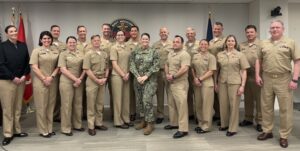
Front row: CDR Svec (RP Specialty Leader), LT Spencer, LT Beadle, LCDR Vorm, LT NeSmith, CDR Massey (MSC HCS Detailer), LT Casachahua, CDR Smallidge, CAPT Shobe, CAPT Foster (AEP Specialty Leader)
Back row: LCDR Geeseman, LCDR Natali, LCDR Eggan, CDR Cox, CDR Haran, CDR Grubb, CAPT Deniston, CAPT Melton
Story by André B. Sobocinski, Historian
U.S. Navy Bureau of Medicine and Surgery
Regardless of whether they are in the air or at sea, the health and performance of the warfighter is essential to maintaining maritime superiority. The Aerospace Experimental Psychology (AEP) and Research Psychology (RP) communities in the Medical Service Corps work tirelessly leveraging their expertise in selection, training, human factors, safety, executive coaching, research, and acquisitions to optimize warfighter health, readiness, and performance to ensure that our Sailors and Marines are prepared to win tonight and come home safely.
On April 2-3, 2024, the Bureau of Medicine and Surgery (BUMED) in Falls Church, Virginia, hosted the third joint AEP-RP symposium. The two-day symposium ignited critical discussions on support of Navy warfighters, strategic communication, collaborative planning as well as recruiting and retention.
“A joint meeting like this enables us to accomplish more together than we would separately,” said Cdr. Leedjia Svec, Military Deputy of the Warfighter Performance Code at the Office of Naval Research and Research Psychology Specialty Leader. “A rising tide lifts all boats. Our synergy facilitates us both as individual communities and one Navy team. Our future fight will be won through collaboration.”
For Capt. Chris Foster, Military Director, Human Systems Engineering Department at the Naval Air Warfare Center Aircraft Division (NAWCAD) and Aerospace Experimental Psychology Specialty Leader, the meeting brought tremendous synergy.
“We are committed to communicating with a joint voice to showcase what our communities offer and how we can empower our warfighter customers,” said Foster. “By collaborating and strategically communicating our value, we can bridge the gap between our expertise and the needs of the Navy. This will not only help to enable optimal performance across all domains but also pave the way for the continued growth of Research Psychology and Aerospace Experimental Psychology within the Navy in a manner that best supports our customers’ needs.”
While AEPs and RPs share similar skillsets, they are each focused on unique mission sets and typically support different customer bases across the service.
RPs are doctoral-level scientists who “apply their expertise in the psychological and behavioral sciences to protect, promote, and enhance the United States Navy’s warfighting capabilities.”
AEPs promote and ensure the “safe and effective performance of Navy aviation personnel” and provide the Navy with “professional and technical guidance and assistance in the planning and conducting of research, development of new systems, and testing and evaluation.”
While RPs are dedicated to supporting the surface and undersea environments, AEPs are focused on the critical areas across the aerospace domain. Both communities, two of the smallest in the Medical Service Corps (MSC), remain the only two non-clinical psychology specialties in the Navy, and each have officers with similar educational backgrounds. While the expertise these two communities bring to bear overlap significantly, the training and experience required to prepare them to support the unique needs of their customers are quite distinct.
This talent pool was evident at the symposium. Attendees represented over 25 commands and activities with backgrounds in cognitive psychology, experimental psychology, industrial-organizational psychology, human factors, neuropsychology, and neuroscience.
“When you get us together, you end up with two separate communities that are very well-positioned to support the entire Navy mission,” said Foster. “We may be separate due to our distinct mission sets and required training experiences, but we share overlapping educational backgrounds, allowing us to bridge the gap and work together to address multi-domain mission challenges.”
The meeting offered an opportunity to strategize how the communities can better align to Navy Medicine’s focus (North Star), while also offering a platform to discuss the challenges and opportunities ahead. Among the opportunities discussed were the roles these communities play in acquisition management.
“With over half of RPs and AEPs being acquisition certified in program management or engineering and technical management, this expertise will be invaluable in leveraging knowledge and experience in acquisitions to support Navy Medicine and Navy priorities,” noted Capt. Katherine Shobe, RP and commanding officer, Naval Medical Leader & Professional Development Command.
The 2024 symposium served as a powerful testament to the potential of collaboration. By fostering open communication and leveraging diverse expertise, these communities can ensure the Navy remains at the forefront of human performance optimization, ultimately supporting the success of its missions across all domains.
Lt. Maria Spencer, an RP who serves as the Director of Training and Curriculum at Naval Station Training Command, Great Lakes, and a first-time attendee to this joint meeting, found it to be a rewarding experience.
“We are both small communities within the Navy, and we often find ourselves explaining who we are and what we do,” said Spencer. “This time was so valuable to have the opportunity to deep-dive into who we are and what we do with a group that understands each other and has a great degree of camaraderie.”
Lt. Rebecca NeSmith, an AEP currently stationed at the Naval Aerospace Medical Institute (NAMI) at Naval Air Station Pensacola, expressed confidence that this meeting will lead to meaningful opportunities for future collaboration.
“I look forward to strengthening AEP / RP connections in the future due to some interesting parallels in our work,” said NeSmith. “For example, both communities are studying vigilance, but while RPs are working with submariners and AEPs are working with pilots, NFO’s, and flight students. I am excited to learn how they are tackling this construct, what similarities or differences exist between these populations, and how we can increase the effectiveness of our efforts through collaboration.”